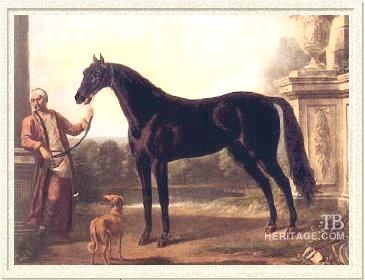|
|
Byerley Turk

|
|
 |
|
|
The story of the Byerley Turk begins at the seige of Buda in Hungary in 1688, when a fine brown charger was taken from a captured Turkish officer by Captain Robert Byerley of the Sixth Dragoon Guards under King William III of Orange. The horse was believed to be about eight years old at the time, placing his year of birth at around 1679. The stallion served as Byerley's war horse when he was dispatched to Ireland in 1689 during King William's War. In 1690, public records show a race meeting was held in the spring at Down Royal in Northern Ireland, at which the top prize, the Silver Bell, was won by Captain Byerley's charger. Later that same year, the stallion was used during the Battle of the Boyne, July 12, 1690, versus the forces of King James II. [His biography up to this point closely parallels that of the Lister Turk, also captured at the seige of Buda and taken to Ireland to serve in the Battle of the Boyne.]
The Byerley Turk first entered stud in England, at the family seat at Middridge Grange, County Durham and later stood at Byerley's Goldsborough Hall, near Knaresborough, in Yorkshire. It is said that he covered few "bred" mares during either period of his stud career, which makes the results even more remarkable. He was known to be at stud as late as 1701, the year he sired Basto (foaled in 1702). It's possible that his remains are buried somewhere on the Goldsborough estate.
Robert Byerley was born in 1660, a son of Col. Anthony Byerley of Middridge Grange, a cavalry officer under Charles I, his unit known as "Byerley's Bulldogs." Robert Byerley rose through the ranks to Captain and was made Colonel in 1688. He married Mary, a grandniece of Philip (4th) Lord Wharton, also a prominent horse breeder of the time. Byerley later removed from Middridge Grange to Goldsborough Hall, and died in May 1714, to be buried at Goldsborough. The Goldsborough estate was sold to the Lascelles family around 1766, upon the death of Elizabeth Byerley.
As his portrait by Wootton shows, the Byerley Turk was a unmarked, dark brown horse with a decidedly Arabian appearance, despite his title as a "Turk". He was very prepotent, and many of his offspring are noted to have been brown or black like himself.
The most important racing son of the Byerley Turk was Basto, a dark bay colt bred by Sir William Ramsden, whose also bred the famous Byerley Turk mare, founder of family #1. Basto was a very good stallion and was later sold to the Duke of Devonshire, in whose ownership he died in 1723, at Chatsworth in Derbyshire. Wootton's portrait of Basto shows a nearly black horse with no white markings, similar in appearance to his own sire. Basto sired Soreheels and the important sister to Soreheels (dam of Snip, Blacklegs, etc.), the foundation mare Old Ebony (family #5), Brown Betty, Old Coquette, and a sister to Coquette among his several progeny in the GSB.
But the Byerley Turk's most influential son was Jigg, which the General Stud Book describes as a "middling" horse who was covering country mares on a travelling basis in Lincolnshire until his son Partner began to sweep all before him as a six-year-old. Partner, "a capital horse", was a tremendous runner and extremely influential sire, although it's Partner's son Tartar, actually one of his lesser efforts, that carries the sireline into the future. Tartar sired Herod.
Jigg's other progeny included Shock, Saucebox, and Robinson Crusoe (sire of Bucephalus), in addition to the dams of Coneyskins (an important early sire), Heneage's Whitenose, Heneage's Jigg, Bolton Patriot, Whimsey, and Brisk.
The Byerley Turk also sired Bristol's (or Mostyn's) Grasshopper, sire of Golden Locks, Look-at-me-Lads, the dam of Gentleman, and her sister. Another son, the Duke of Rutland's Black Hearty sired the great racemare Bonny Black, considered the best runner of her age. Other good runners by the Byerley Turk include Sprite, Archer, Lord Godolphin's Byerley Gelding, Halloway's Jigg and Knightley's Mare.
Byerley Turk mares became jewels of great price. Two of his daughters have been determined to be taproot mares for the breed. First was the daughter of the Taffolet Barb mare (three generations descended from Tregonwell's Natural Barb Mare, family #1).
Another Byerley Turk daughter known as "Dam of the Two True Blues" was designated founder of family #3. She was bred by Mr. Bowes of Streatleam, Co. Durham, a stud only ten miles from Middridge Grange, and so was foaled in the early part of the Byerley Turk's career. This mare's dam was unknown, and it has been speculated that these two daughters of the Byerley Turk are one and the same, but this can't be proven.
Other mares sired by the Byerley Turk include the only daughter of the mare by Bustler, founder of family #8, and the only daughter of another mare by Bustler, founder of family #35. He also sired the dams of Bulle Rock (allegedly the first "bred" stallion imported into Virginia), Smales' Childers, Fortune (also imported into the U.S.), the Farmer Mare, and The Wharton Mare.
--Anne Peters |
|
|
|

